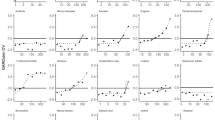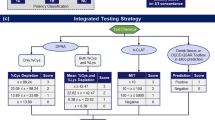Abstract
In analogy to the Threshold of Toxicological Concern concept, a Threshold of Sensitization Concern (TSC) concept is proposed for chemicals with respect to their ability to induce an allergic contact dermatitis. Recently, the derivation of a dermal sensitization threshold was suggested based on an evaluation of animal data. In order to establish the concept with human data, we conducted a meta-analysis taking into account No Expected Sensitization Induction Levels for fragrance ingredients from the IFRA/RIFM dataset. Based on a statistical analysis by applying Sensitization Assessment Factors that account for interindividual variability and different exposure conditions, TSC values of 0.91 or 0.30 μg/cm2 can be derived in terms of amount per skin area. TSC values are compared with typical exposure levels of cosmetic products. A substance can be considered to be virtually safe if the quotient of exposure level and TSC is <1. The findings derived from human data include several conservative assumptions and largely support the dermal sensitization thresholds previously derived from animal data. The TSC concept might in principle be used for any untested chemical and therefore help in some cases to waive animal testing.


Similar content being viewed by others
Abbreviations
- AEL:
-
Acceptable Exposure Level
- Deo/AP:
-
Deodorants/antiperspirants
- EC3:
-
Effective concentration inducing a threefold increase of lymph node responses compared to controls
- ECETOC:
-
European Centre for Ecotoxicology and Toxicology of Chemicals
- ELINCS:
-
European list of notified substances
- HRIPT:
-
Human repeated insult patch test
- IFRA:
-
International Fragrance Association
- LLNA:
-
Local lymph node assay
- NESIL:
-
No Expected Sensitization Induction Level
- NO(A)EL:
-
No Observed (Adverse) Effect Level
- QRA:
-
Quantitative risk assessment
- (Q)SAR:
-
(Quantitative) Structure Activity Relationship
- REACH:
-
Registration, Evaluation and Authorisation of Chemicals
- RIFM:
-
Research Institute for Fragrance Materials, Inc.
- SAF:
-
Sensitization Assessment Factor
- TSC:
-
Threshold of Sensitization Concern
- TTC:
-
Threshold of Toxicological Concern
References
Api AM (2002) Sensitization methodology and primary prevention of the research institute for fragrance materials. Dermatology (Basel, Switzerland) 205:84–87
Api AM, Basketter DA, Cadby A, Cano M-F, Ellis G, Gerberick GF, Griem P, McNamee PM, Ryan CA, Safford B (2006) Dermal sensitization quantitative risk assessment (QRA) for fragrance ingredients. Toxicologist 90:465
Api AM, Basketter DA, Cadby PA, Cano MF, Ellis G, Gerberick GF, Griem P, McNamee PM, Ryan CA, Safford R (2008) Dermal sensitization quantitative risk assessment (QRA) for fragrance ingredients. Regul Toxicol Pharmacol 52:3–23
Azzalini A (1985) A class of distributions which includes the normal ones. Scand J Statis 12:171–178
Azzalini A (2008) R package ‘sn’: the skew-normal and skew-t distributions (version 0.4-10). http://azzalini.stat.unipd.it/SN
Bailey NTJ (1995) Statistical methods in biology. Cambridge University Press, Cambridge
Barratt MD, Langowski JJ (1999) Validation and subsequent development of the DEREK skin sensitization rulebase by analysis of the BgVV list of contact allergens. J Chem Inf Comput Sci 39:294–298
Basketter DA, Andersen KE, Liden C, Van Loveren H, Boman A, Kimber I, Alanko K, Berggren E (2005a) Evaluation of the skin sensitizing potency of chemicals by using the existing methods and considerations of relevance for elicitation. Contact Derm 52:39–43
Basketter DA, Clapp C, Jefferies D, Safford B, Ryan CA, Gerberick F, Dearman RJ, Kimber I (2005b) Predictive identification of human skin sensitization thresholds. Contact Derm 53:260–267
Blackburn K, Stickney JA, Carlson-Lynch HL, McGinnis PM, Chappell L, Felter SP (2005) Application of the threshold of toxicological concern approach to ingredients in personal and household care products. Regul Toxicol Pharmacol 43:249–259
EFFA (2008) EFFA code of practice 2008 version 2 for the hazard classification and labelling and for transport of flavour and fragrance substances and preparations according to the EU-regulations (Attachment 1-3). http://www.effa.be/cop_2008.htm
Frawley JP (1967) Scientific evidence and common sense as a basis for food-packaging regulations. Food Cosmet Toxicol 5:293–308
Gerberick GF, Robinson MK, Felter SP, White IR, Basketter DA (2001) Understanding fragrance allergy using an exposure-based risk assessment approach. Contact Derm 45:333–340
Gerberick GF, Ryan CA, Kern PS, Schlatter H, Dearman RJ, Kimber I, Patlewicz GY, Basketter DA (2005) Compilation of historical local lymph node data for evaluation of skin sensitization alternative methods. Dermatitis 16:157–202
Healy MJ (1979) Outliers in clinical chemistry quality-control schemes. Clin Chem 25:675–677
International Fragrance Association (2003) IFRA Standard—linalool—38th Amendment
International Fragrance Association (2006a) IFRA Standard—citral—40th Amendment
International Fragrance Association (2006b) IFRA Standard—farnesol—40th Amendment
International Fragrance Association (2006c) IFRA Standard—phenylacetaldehyde—40th Amendment
International Fragrance Association (2007a) IFRA Standard—alpha-amyl cinnamic alcohol—42nd Amendment
International Fragrance Association (2007b) IFRA Standard—alpha- amyl cinnamic aldehyde—42nd Amendment
International Fragrance Association (2007c) IFRA Standard—alpha-hexyl cinnamic aldehyde—42nd Amendment
International Fragrance Association (2007d) IFRA Standard—alpha-methyl cinnamic aldehyde—42nd Amendment
International Fragrance Association (2007e) IFRA Standard—anisyl alcohol—42nd Amendment
International Fragrance Association (2007f) IFRA Standard—benzyl alcohol—42nd Amendment
International Fragrance Association (2007g) IFRA Standard—benzyl benzoate—42nd Amendment
International Fragrance Association (2007h) IFRA Standard—benzyl cinnamate—42nd Amendment
International Fragrance Association (2007i) IFRA Standard—benzyl salicylate—42nd Amendment
International Fragrance Association (2007j) IFRA Standard—citronellol—42nd Amendment
International Fragrance Association (2007k) IFRA Standard—geraniol—42nd Amendment
International Fragrance Association (2007l) IFRA Standard—hexyl salicylate—42nd Amendment
International Fragrance Association (2007m) IFRA Standard—isocyclocitral—42nd Amendment
International Fragrance Association (2008a) IFRA Standard—1-(1,2,3,4,5,6,7,8-octahydro-2,3,8,8-tetramethyl-2-naphthalenyl) ethanone (OTNE)—43rd Amendment
International Fragrance Association (2008b) IFRA Standard—1-octen-3-yl acetate—43rd Amendment
International Fragrance Association (2008c) IFRA Standard—2-ethoxy-4-methylphenol—43rd Amendment
International Fragrance Association (2008d) IFRA Standard—2-methoxy-4-methylphenol—43rd Amendment
International Fragrance Association (2008e) IFRA Standard—2,2-dimethyl-3-(3-tolyl)propan-1-ol—43rd Amendment
International Fragrance Association (2008f) IFRA Standard—3-propylidenephthalide—43rd Amendment
International Fragrance Association (2008g) IFRA Standard—3 and 4-(4-hydroxy-4-methylpentyl)-3-cyclohexene-1-carboxaldehyde (HMPCC)—43rd Amendment
International Fragrance Association (2008h) IFRA Standard—alpha-43A hexylidene cyclopentanone—43rd Amendment
International Fragrance Association (2008i) IFRA Standard—carvone—43rd Amendment
International Fragrance Association (2008j) IFRA Standard—cinnamic alcohol—43rd Amendment
International Fragrance Association (2008k) IFRA Standard—cinnamic aldehyde—43rd Amendment
International Fragrance Association (2008l) IFRA Standard—cinnamyl nitrile—43rd Amendment
International Fragrance Association (2008m) IFRA Standard—coumarin—43rd Amendment
International Fragrance Association (2008n) IFRA Standard—eugenol—43rd Amendment
International Fragrance Association (2008o) IFRA Standard—hydroxycitronellal—43rd Amendment
International Fragrance Association (2008p) IFRA Standard—isocyclogeraniol—43rd Amendment
International Fragrance Association (2008q) IFRA Standard—isoeugenol—43rd Amendment
International Fragrance Association (2008r) IFRA Standard—jasmine absolute (grandiflorum)—43rd Amendment
International Fragrance Association (2008s) IFRA Standard—jasmine absolute (sambac)—43rd Amendment
International Fragrance Association (2008t) IFRA Standard—menthadiene-7-methyl formate—43rd Amendment
International Fragrance Association (2008u) IFRA Standard—methoxy dicyclopentadiene carboxaldehyde (scentenal)—43rd Amendment
International Fragrance Association (2008v) IFRA Standard—methyl heptine carbonate—43rd Amendment
International Fragrance Association (2008w) IFRA Standard—methyl ionone, mixed isomers—43rd Amendment
International Fragrance Association (2008x) IFRA Standard—methyl octine carbonate—43rd Amendment
International Fragrance Association (2008y) IFRA Standard—Oakmoss Extracts—43rd Amendment
International Fragrance Association (2008β) IFRA Standard—p-tert-butyldihydrocinnamaldehyde (bourgeonal)—43rd Amendment
International Fragrance Association (2008α) IFRA Standard—p-tert-butyl-alpha-methylhydrocinnamic aldehyde (BMHCA)—43rd Amendment
International Fragrance Association (2008γ) IFRA Standard—peru balsam extracts and distillates—43rd Amendment
International Fragrance Association (2008δ) IFRA Standard—rose ketones—43rd Amendment
International Fragrance Association (2008ζ) IFRA Standard—treemoss extracts—43rd Amendment
International Fragrance Association (2008ε) IFRA Standard—trans-2-hexenal—43rd Amendment
International Fragrance Association (2008η) IFRA Standard—ylang ylang extracts—43rd Amendment
International Fragrance Association (2008z) IFRA Standard—p-mentha-1,8-dien-7-al (perilla aldehyde)—43rd Amendment
Kimber I, Basketter DA, Butler M, Gamer A, Garrigue JL, Gerberick GF, Newsome C, Steiling W, Vohr HW (2003) Classification of contact allergens according to potency: proposals. Food Chem Toxicol 41:1799–1809
Kroes R, Galli C, Munro I, Schilter B, Tran L, Walker R, Wurtzen G (2000) Threshold of toxicological concern for chemical substances present in the diet: a practical tool for assessing the need for toxicity testing. Food Chem Toxicol 38:255–312
Kroes R, Renwick AG, Cheeseman M, Kleiner J, Mangelsdorf I, Piersma A, Schilter B, Schlatter J, van Schothorst F, Vos JG, Wurtzen G (2004) Structure-based thresholds of toxicological concern (TTC): guidance for application to substances present at low levels in the diet. Food Chem Toxicol 42:65–83
Kroes R, Kleiner J, Renwick A (2005) The threshold of toxicological concern concept in risk assessment. Toxicol Sci 86:226–230
Kroes R, Renwick AG, Feron V, Galli CL, Gibney M, Greim H, Guy RH, Lhuguenot JC, van de Sandt JJ (2007) Application of the threshold of toxicological concern (TTC) to the safety evaluation of cosmetic ingredients. Food Chem Toxicol 45:2533–2562
Langton K, Patlewicz GY, Long A, Marchant CA, Basketter DA (2006) Structure-activity relationships for skin sensitization: recent improvements to derek for windows. Contact Derm 55:342–347
McNamee PM, Api AM, Basketter DA, Frank Gerberick G, Gilpin DA, Hall BM, Jowsey I, Robinson MK (2008) A review of critical factors in the conduct and interpretation of the human repeat insult patch test. Regul Toxicol Pharmacol. 52(1):24–34
Munro IC, Ford RA, Kennepohl E, Sprenger JG (1996) Correlation of structural class with no-observed-effect levels: a proposal for establishing a threshold of concern. Food Chem Toxicol 34:829–867
Oppel T, Schnuch A (2006) Häufigste Auslöser allergischer Kontaktekzeme (The most frequent allergens in allergic contact dermatitis). Dtsch Med Wochenschr 131:1584–1589
Politano VT, Api AM (2008) The research institute for fragrance materials’ human repeated insult patch test protocol. Regul Toxicol Pharmacol. 52(1):35–38
R-Development-Core-Team (2008) R: a language and environment for statistical computing. Vienna, Austria
Renwick AG (2004) Toxicology databases and the concept of thresholds of toxicological concern as used by the JECFA for the safety evaluation of flavouring agents. Toxicol Lett 149:223–234
Rulis AM (1986) De minimis and the threshold of regulation. In: Felix CW (ed) Food protection technology. Lewis Publishers, Chelsea, pp 29–37
Safford RJ (2008) The dermal sensitisation threshold-A TTC approach for allergic contact dermatitis. Regul Toxicol Pharmacol 51(2):195–200
Schnuch A, Geier J, Uter W, Frosch PJ, Lehmacher W, Aberer W, Agathos M, Arnold R, Fuchs T, Laubstein B, Lischka G, Pietrzyk PM, Rakoski J, Richter G, Rueff F (1997) National rates and regional differences in sensitization to allergens of the standard series. Population-adjusted frequencies of sensitization (PAFS) in 40, 000 patients from a multicenter study (IVDK). Contact Derm 37:200–209
Schnuch A, Uter W, Geier J, Lessmann H, Frosch PJ (2007) Sensitization to 26 fragrances to be labelled according to current European regulation. Results of the IVDK and review of the literature. Contact Derm 57:1–10
Varmuza K (1998) Chemometrics: multivariate view on chemical problems. In: Schleyer PVR, Allinger NL, Clark T, Gasteiger J, Kollman PA, Schaefer HFIII, Schreiner PR (eds) Encyclopedia of computational chemistry. Wiley, Chichester, pp 346–366
Acknowledgments
The authors would like to thank Elke Mertens for editorial assistance and Winfried Steiling for reviewing the manuscript.
Author information
Authors and Affiliations
Corresponding author
Rights and permissions
About this article
Cite this article
Keller, D., Krauledat, M. & Scheel, J. Feasibility study to support a threshold of sensitization concern concept in risk assessment based on human data. Arch Toxicol 83, 1049–1060 (2009). https://doi.org/10.1007/s00204-009-0460-9
Received:
Accepted:
Published:
Issue Date:
DOI: https://doi.org/10.1007/s00204-009-0460-9




